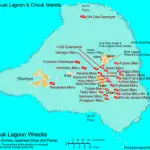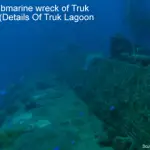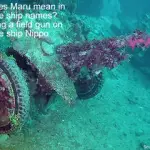
What are the deepest, biggest and most popular Truk Lagoon Wrecks?
I have spent a bit of time compiling a list of the Truk Lagoon wrecks. If you’re planning a trip to Truk or Chuuk Lagoon, I’m hoping this article will help you do just that. However, please add a comment below, if it could be improved in any way.
The best way to dive Truk Lagoon is by a scuba diving liveaboard. You can check the latest and best deals on Truk Lagoon liveaboards using the following window:
Truk Lagoon wrecks or Chuuk Lagoon wrecks?
Truk Lagoon is the name these Pacific lagoons and islands were named in 1944 when they were in Japanese occupation. However, the name of Truk Lagoon was changed in 1990 to Chuuk Lagoon.
Scuba divers seem to use these two names synonymously. Whilst the correct name is Chuuk Lagoon, at the time these ship wrecks were sunk it was named Truk Lagoon.
The Chuuk Lagoon wrecks are now dived by scuba divers across the world.
Truk Lagoon dive liveaboards table
This list of Truk Lagoon liveaboards is in descending customer rating order, followed by Scuba Diving Luxury Rating (SDE Lux Rating, see below), so the liveaboards with the highest customer rating and the best SDE lux rating will be at the top of the list. If you want to change the list order, use the “Sort by” dropdown below.
| Discover Liveaboard | Customer Rating | SDE Lux Rating % | Flexible Booking | Dive Courses | Dietary Requirements | Nitrox | Gear Rental | |
|---|---|---|---|---|---|---|---|---|
 |
Review: SS Thorfinn; Book: SS Thorfinn | 8.8 | 88% | YES | YES | YES | YES | YES |
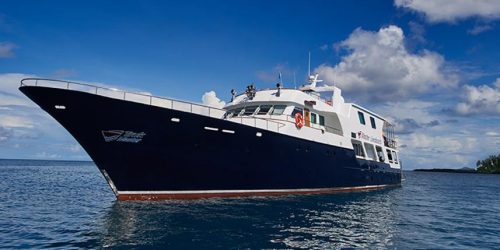 |
Review: MV Truk Master; Book: MV Truk Master | 7.9 | 65% | YES | NO | YES | YES | YES |
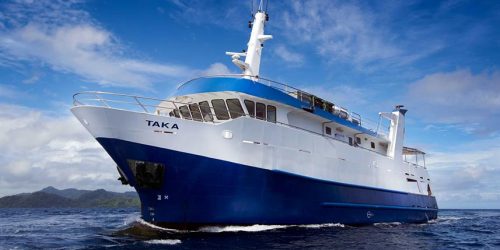 |
Review: MV Pacific Master; Book: MV Pacific Master | 0 | 56% | YES | YES | YES | YES | YES |
The Scuba Diving Earth Luxury Rating (SDE Lux Rating) is explained on each liveaboard review when you click the “Discover Liveaboard” link, and is my own Liveaboard Luxury Rating I’ve assigned to all liveaboards. Choosing between liveaboards is helped by customer scores, and if you get stuck choosing between two or three liveaboards, where each one has a high customer score out of 10, you can use the SDE Luxury Rating to help narrow down your choice.
Think about it like using Booking.com when searching for the best hotel. Booking.com also use a customer score where each customer rates hotels out of 10. This is similar to the liveaboard customer rating, which is also rated out of 10. But let’s say you only like to stay in hotels rated 8 and above on Booking.com, but you also want the hotel to have WIFI or parking, or to have a swimming pool etc. The features each hotel has is usually secondary to the score out of 10.
For the purpose of this article, I am going to continue referring to Truk Lagoon as Chuuk Lagoon instead.
Chuuk Lagoon wrecks – A complete list in alphabetical order
Below is a table showing the majority of the Chuuk Lagoon wrecks for scuba diving. To scroll through the wrecks, click on the ‘Next’ button below and then to scroll back, click on the ‘Previous’button.
You can also search for a specific wreck too in the search box below.
| Truck Lagoon Wrecks or Chuuk Lagoon Wrecks for scuba divers |
|---|
Aikoku Maru |
| Type: |
| Converted armed merchant cruiser |
| Weight: |
| 10437 tons |
| Length: |
| 161 metres (527 feet) |
| Beam: |
| 20 metres (66 feet) |
| Depth: |
| 24-64 metres (80-210 feet) |
| Location: |
| East of Dublon |
| Comments: |
| She was reconverted to a transport ship. This wreck has been know to emit a skin-burning substance, which is possibly fuel. Limited diving due to depth and its exposed location. |
Amigisan Maru |
| Type: |
| Armed passenger-cargo transport ship |
| Weight: |
| 7620 tons |
| Length: |
| 137 metres (450 feet) |
| Beam: |
| 18 metres (60 feet) |
| Depth: |
| 34 metres (110 feet) |
| Location: |
| Southwest of Uman |
| Comments: |
| Excellent visibility. She has a gun on her bow and there are manyartifacts |
Fujikawa Maru |
| Type: |
| Converted aircraft transport |
| Weight: |
| 6938 tons |
| Length: |
| 133 metres (436 feet) |
| Beam: |
| 18 metres (59 feet) |
| Depth: |
| 15-37 metres (50-120 feet) |
| Location: |
| South of Eten |
| Comments: |
| One of her masks breaks the surface. One of the top wrecks of Truk Lagoon. Hold contains ZEKE fighters and other equipment. Outer upper deck is covered with corals, sponges and algae. Has a large deck gun |
Fujisan Maru |
| Type: |
| Tanker |
| Weight: |
| 9524 tons |
| Length: |
| 149 metres (490 feet) |
| Beam: |
| 20 metres (65 feet) |
| Depth: |
| 37-61 metres (120-200 feet) |
| Location: |
| Southest of Moen |
| Comments: |
| Small amounts of coral growth. Has many artifacts to explore. |
Fumitsuki Destroyer |
| Type: |
| Mutsuki Class Destroyer |
| Weight: |
| 1913 tons |
| Length: |
| 97 metres (320 feet) |
| Beam: |
| 9 metres (30 feet) |
| Depth: |
| 30-40 metres (100-130 feet) |
| Location: |
| North-west of Fefan Island and west of the southern end of Moen Island |
| Comments: |
| One of two destroyers and one of three purpose built war ships of Truk Lagoon. Sits upright, listing to port. Extensive marine growth, many schools of fish. Stern uplifted by explosion. There is a bow gun near the forecastle, Long Lance torpedo launchers between the forecastle and bridge, and aft gun and winches, cables and depth charge throwers are on the stern. |
Futagami Tugboat |
| Type: |
| Tug boat |
| Weight: |
| 625 tons |
| Length: |
| 12 metres (40 feet) |
| Beam: |
| 2 metres (6 feet) |
| Depth: |
| 15-28 metres (50-92 feet) |
| Location: |
| Near Tonoas |
| Comments: |
| In the bridge there are twin telegraphs and wheel housing. Visibility not so good on this wreck. |
Gosei Maru |
| Type: |
| Cargo transport |
| Weight: |
| 1931 tons |
| Length: |
| 83 metres (272 feet) |
| Beam: |
| 12 metres (40 feet) |
| Depth: |
| 3-37 metres (10-120 feet) |
| Location: |
| 183 metres (200 yards) off the east side of Uman |
| Comments: |
| Abundant sea life and a popular wreck with scuba divers. She is a flat bottomed boat used to load and unload ships at anchor. |
Heian Maru |
| Type: |
| Converted submarine tender |
| Weight: |
| 11614 tons |
| Length: |
| 155 metres (510 feet) |
| Beam: |
| 20 metres (66 feet) |
| Depth: |
| 15-34 metres (50-110 feet) |
| Location: |
| 457 metres (500 yards) west of Dublon |
| Comments: |
| Largest wreck in the lagoon with a large deck gun on the stern |
Hino Maru No. 2 |
| Type: |
| Gunboat and sub chaser |
| Weight: |
| 9998 tons |
| Length: |
| 6 (200 feet)1 metres |
| Beam: |
| 11 metres (35 feet) |
| Depth: |
| 3-18 metres (9-60 feet) |
| Location: |
| West of Uman |
| Comments: |
| Known as the Gun High wreck. Although the bow is on 6 feet from the surface, the deck gun is just 3 feet from the surface. Plenty of photographic opportunities and is good for snorklelling. |
Hoki Maru |
| Type: |
| Cargo transport |
| Weight: |
| 7112 tons |
| Length: |
| 137 metres (450 feet) |
| Beam: |
| 18 metres (59 feet) |
| Depth: |
| 24-50 metres (80-165 feet) |
| Location: |
| Eten Island anchorage |
| Comments: |
| She was originally declared off limited to scuba divers to to the presence ofcaustic substances. But has since been cleared for diving trips. The holds contain many types of cargo, bombs, ammunition, and vehicles, including a Diesel roller, 4 Isuzu Type 94 trucks, 2 tractors (one similar to a John Deere, the other is a Komatsu), 2 small bulldozers and a prime mover. |
Hokuyo Maru |
| Type: |
| Passenger-cargo transport |
| Weight: |
| 4216 tons |
| Length: |
| 109 metres (358 feet) |
| Beam: |
| 15 metres (49 feet) |
| Depth: |
| 37-61 metres (120-200 feet) |
| Location: |
| Eten Anchorage |
| Comments: |
| Passenger freighter sitting upright, with interesting bridge and engine room. |
Hoyo Maru |
| Type: |
| Oil tanker |
| Weight: |
| 8691 tons |
| Length: |
| 145 metres (475 feet) |
| Beam: |
| 19 metres (61 feet) |
| Depth: |
| 3-30 metres (9-100 feet) |
| Location: |
| 366 metres (400 yards) north of Fefan |
| Comments: |
| Poor visibility due to silt and dangerous for scuba divers to enter |
I-169 Submarine |
| Type: |
| Submarine |
| Weight: |
| 1400 tons |
| Length: |
| 98 metres (322 feet) |
| Beam: |
| 8 metres (27 feet) |
| Depth: |
| 37-43 metres (120-140 feet) |
| Location: |
| West of Dublon |
| Comments: |
| Considered dangerous to enter. Not dived as much by divers, due to the lack of penetration and coral formations on the outside |
Kansho Maru |
| Type: |
| Passenger cargo ship |
| Weight: |
| 4862 tons |
| Length: |
| 117 metres (384 feet) |
| Beam: |
| 16 metres (52 feet) |
| Depth: |
| 18-40 metres (60-130 feet) |
| Location: |
| North of Fefan |
| Comments: |
| Considered to be one of the best wrecks in Truk Lagoon to dive. There are many artifacts. Lies upright with 20° list to port. |
Kikukawa Maru |
| Type: |
| Passenger-cargo transport |
| Weight: |
| 3833 tons |
| Length: |
| 108 metres (354 feet) |
| Beam: |
| 15 metres (50 feet) |
| Depth: |
| 21-37 metres (70-120 feet) |
| Location: |
| Eten Island anchorage - East side |
| Comments: |
| Wreck is in poor condition and lies on her starboard side. Only the front half remains, which is upside down. Holds have many airplane parts and fuel drums |
Kiyozumi Maru |
| Type: |
| Converted armed merchant cruiser |
| Weight: |
| 8613 tons |
| Length: |
| 138 metres (453 feet) |
| Beam: |
| 19 metres (61 feet) |
| Depth: |
| 12-37 metres (40-120 feet) |
| Location: |
| 549 metres (600 yards) north of Fefan |
| Comments: |
| Was later converted to a transport ship. It has been leaking oil right up to recently and there's often been a slick visible at the surface. |
Matsutani Maru or Shotan Maru |
| Type: |
| Cargo ship |
| Weight: |
| 1999 tons |
| Length: |
| 87 metres (285 feet) |
| Beam: |
| 13 metres (43 feet) |
| Depth: |
| 37-46 metres (120-150 feet) |
| Location: |
| Near Fanamu Island |
| Comments: |
| Contains artifacts and No.1 hold has two flatbed trucks with cranes, but only the frames of these remain. There are two AA guns that are near the damaged smokestck. And there's a 3 inch gun at the stern. |
Momokawa Maru |
| Type: |
| Passenger-cargo transport |
| Weight: |
| 3829 tons |
| Length: |
| 107 metres (352 feet) |
| Beam: |
| 15 metres (50 feet) |
| Depth: |
| 37-43 metres (120-140 feet) |
| Location: |
| 1/2 mile from Dublon |
| Comments: |
| Contains many artifacts |
Nagano Maru |
| Type: |
| Passenger-cargo transport |
| Weight: |
| 3824 tons |
| Length: |
| 105 metres (345 feet) |
| Beam: |
| 15 metres (49 feet) |
| Depth: |
| 43-64 metres (140-210 metres) |
| Location: |
| 4th Fleet Anchorage east of Dublon Island |
| Comments: |
| A large intact flatbed truck, a second truck, bulldozer or prime mover truck, machinery items, detached trailers, and a diesel roller can all be found in various holds. There's also a collection of china and serving items. |
Nippo Maru |
| Type: |
| Converted cargo transport ship |
| Weight: |
| 3764 tons |
| Length: |
| 108 metres (353 feet) |
| Beam: |
| 15 metres (49 feet) |
| Depth: |
| 37-47 metres (120-155 feet) |
| Location: |
| East of Dublon |
| Comments: |
| One of the most popular wrecks as it contains a variety of artifacts. There's a battle tank and 3 anti-tank Howitzer guns on the starboard deck. There are very picturesque helm and engine telegraphs providing excellent photo opportunities. The Nippo Maru has such an interesting cargo of war materials (shells, detonators, rifle ammunition), equipment (water tanks, gas masks, mess kits, shoes), and other artifacts (beer bottles) that it has become one of the most popular wrecks in Truk Lagoon. |
Oite |
| Type: |
| Kamikaze Class Destroyer |
| Weight: |
| 1523 tons |
| Length: |
| 100 metres (327 feet) |
| Beam: |
| 9 metres (30 feet) |
| Depth: |
| 52-62 metres (170-205 feet) |
| Location: |
| Towards the north end of the lagoon |
| Comments: |
| Shes in good visibility and there's many artifacts. Her twin propellers can still be seen in the sand. On the stern there’s depth charge throwers with depth charges loaded into a rack nearby, 2 anti aircraft guns and a One of only three actual war-ships which was perpurse built fo the war. 4.7’’ main battery gun. Located on the sand you can find the torpedo launchers with torpedoes loaded inside. |
Ojima |
| Type: |
| Salvage and repairship/tub boat |
| Weight: |
| 812 tons |
| Length: |
| 49 metres (161 feet) |
| Beam: |
| 9 metres (29 feet) |
| Depth: |
| 46-50 metres (150-164 feet) |
| Location: |
| Eten Island anchorage - East side |
| Comments: |
| Has a couple of Daihatsu landing craft on the wreck. |
Reiyo Maru |
| Type: |
| Passenger-cargo transport |
| Weight: |
| 5446 tons |
| Length: |
| 122 metres (400 feet) |
| Beam metres: |
| 16 metres (53 feet) |
| Depth: |
| 53-67 metres (175-220 feet) |
| Location: |
| Eton Anchorage |
| Comments: |
| The holds are mostly empty. Due to her depth, little coral growth is apparent, and it is not often dived. |
Rio De Janeiro |
| Type |
| Converted submarine tender |
| Weight |
| 9626 tons |
| Length |
| 141 metres (461 feet) |
| Beam metres |
| 19 metres (62) |
| Depth |
| 10-33 metres (35-110 feet) |
| Location |
| 457 metres (500 yards) off the east side of Uman |
| Comments |
| This was reconverted to a transport ship. Has large deck guns. There's abundant see life and great visibility. She lies on her starboard side. |
San Francisco Maru |
| Type: |
| Passenger-cargo transport |
| Weight: |
| 5831 tons |
| Length: |
| 117 metres (385 feet) |
| Beam: |
| 16 metres (52 feet) |
| Depth: |
| 42-64 metres (140-210 feet) |
| Location: |
| Eten Island anchorage - East side |
| Comments: |
| Considered to be one of the most exciting of wrecks in Truk Lagoon. Many artifacts |
Sankisan Maru |
| Type: |
| Cargo transport |
| Weight: |
| 4752 tons |
| Length: |
| 116 metres (380 feet) |
| Beam: |
| 16 metres (53 feet) |
| Depth: |
| 15-30 metres (49-100 feet) |
| Location: |
| West of Uman |
| Comments: |
| Has several trucks lashed to the deck. There are many artifacts. Mostof the forward deck is covered in coral, plus an abundance of sea life and excellent visibility |
Seiko Maru |
| Type: |
| Cargo ship |
| Weight: |
| 5385 tons |
| Length: |
| 119 metres (392 feet) |
| Beam : |
| 16 metres (53 feet) |
| Depth: |
| 23-49 metres (75-160 feet) |
| Location: |
| Eten Island anchorage - East side |
| Comments: |
| China and other artifacts in superstructure. Field gun on bow. The wreck is in a reasonably good stage of preservation, but due to its depth, it is rarely visited. |
Shinkoka Maru |
| Type: |
| Oil tanker |
| Weight: |
| 10200 tons |
| Length: |
| 152 metres (500 feet) |
| Beam: |
| 20 metres (65 feet) |
| Depth: |
| 12-40 metres (40-130 feet) |
| Location: |
| 3.5 miles southwest of Moen |
| Comments: |
| Wreck is in excellent condition and contains many artifacts. Her forward deck is covered in soft coral and there's plenty of marine life. |
Susuki Patrol Boat No. 34 |
| Type: |
| Converted patrol boat/sub chaser |
| Weight: |
| 770 tons |
| Length: |
| 84 metres (275 feet) |
| Beam: |
| 8 metres (26 feet) |
| Depth: |
| 3-15 metres (10-50 feet) |
| Location: |
| Between Fefan (Northeast) and Dublon (Southwest}) |
| Comments: |
| Lies upright and lists 20° to port |
Taiho Maru |
| Type: |
| Cargo transport |
| Weight: |
| 2827 tons |
| Length: |
| 93 metres (305 feet) |
| Beam: |
| 14 metres (45 feet) |
| Depth: |
| 27-44 metres (90-145 feet) |
| Location: |
| South of Fefan |
| Comments: |
| Was dangerous to scuba divers as it's leaking aviation fuel. Many fuel drums and 2 landing craft nearby. |
Tonan Maru No. 3 |
| Type: |
| Converted tanker |
| Weight: |
| 19209 tons |
| Length: |
| 163 metres (535 feet) |
| Beam: |
| 23 metres (75 feet) |
| Depth: |
| Salvaged post war |
| Location: |
| Salvaged post war |
| Comments: |
| Prior to the war she was used as a whale factory. Only remnants are left as the Totnan Maru No. 3 was raise for salvage after the warNothern part of the Fenan Dublon channel anchorage |
Unkai Maru No. 6 |
| Type: |
| Cargo transport |
| Weight: |
| 3220 tons |
| Length; |
| 101 metres (331 feet) |
| Beam: |
| 15 metres (49 feet) |
| Depth: |
| 24-40 metres (80-130 feet) |
| Location: |
| North of Uman |
| Comments: |
| Lies upright on the bottom. Has a 3 inch bow gun. Many artifacts can be found on this wreck, including boots, shoes and gas masks. |
Yamagiri Maru |
| Type: |
| Passenger cargo transport ship |
| Weight: |
| 6438 tons |
| Length: |
| 134 metres (439 feet) |
| Beam: |
| 18 metres (58 feet) |
| Depth: |
| 15-34 metres (50-110 feet) |
| Location: |
| North-northwest of Fefan |
| Comments: |
| There arer 18-inch warheads in the hold which were for the battle ships Masashi and Yamato. There's plenty of sea fans and corals across her bridge. There are 6 holds large and open enough to swim into. In the engine room there was a skull embedded into the overhead space. Large masts and two depth charges, one each side of the stern still in their racks. |
Yubai Maru |
| Type: |
| Cargo transport |
| Weight: |
| 3217 tons |
| Length: |
| 93 metres (305 feet) |
| Beam: |
| 13 metres (44 feet) |
| Depth: |
| 15-36 metres (50-118 feet) |
| Location: |
| West of Uman, Near Fefan |
| Comments: |
| Lies on her port side. The engine room has the gauges, telegraph and boilers. Lots of hard coral is forming on the huge keel. |
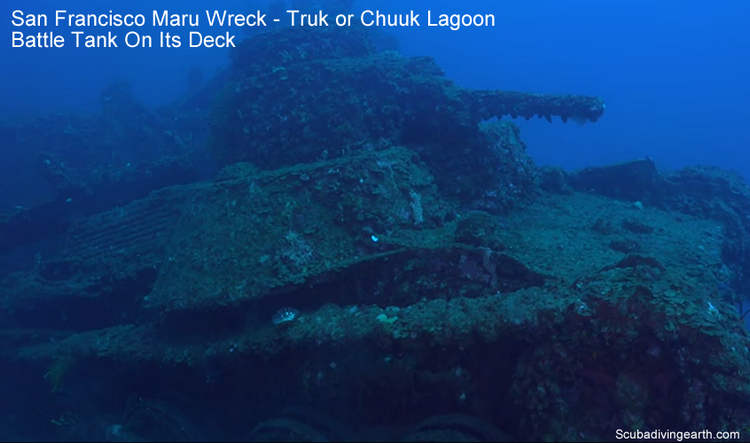
Which are the deepest of the Truk Lagoon Wrecks?
Truk Lagoon wreck diving depths range from a shallow 15 metres (50 feet) to 67 metres (220 feet).
One of the deepest wreck of Truk Lagoon, or should I say Chuuk Lagoon is the San Francisco Maru. But not the deepest.
- She lies in 64 metres (210 feet) of water.
- Only the most advanced divers can diver the San Francisco Maru wreck.
- The shallowest part of the San Francisco Maru wreck is at 42 metres (140 feet). This means that you can’t dive for too long before going into decompression stop diving.
- The San Francisco Maru wreck was a passenger cargo ship measuring 117 metres (385 feet).
- She was 5,831 tons.
- The San Francisco Maru operated in world trade operations in minerals such as coal, bauxite, and phosphate for transportation to the Japanese Empire.
- This passenger-Cargo ship was built in 1919 for Yamashita Kisen Kabushiki Kaisha.
I include the San Francisco Maru first in the deepest Chuuk Lagoon wrecks, as she is considered to be one of the most exciting of the Chuuk Lagoon wrecks. She has many artefacts still remaining in her midst. This includes a battle tank, as featured in the above image.
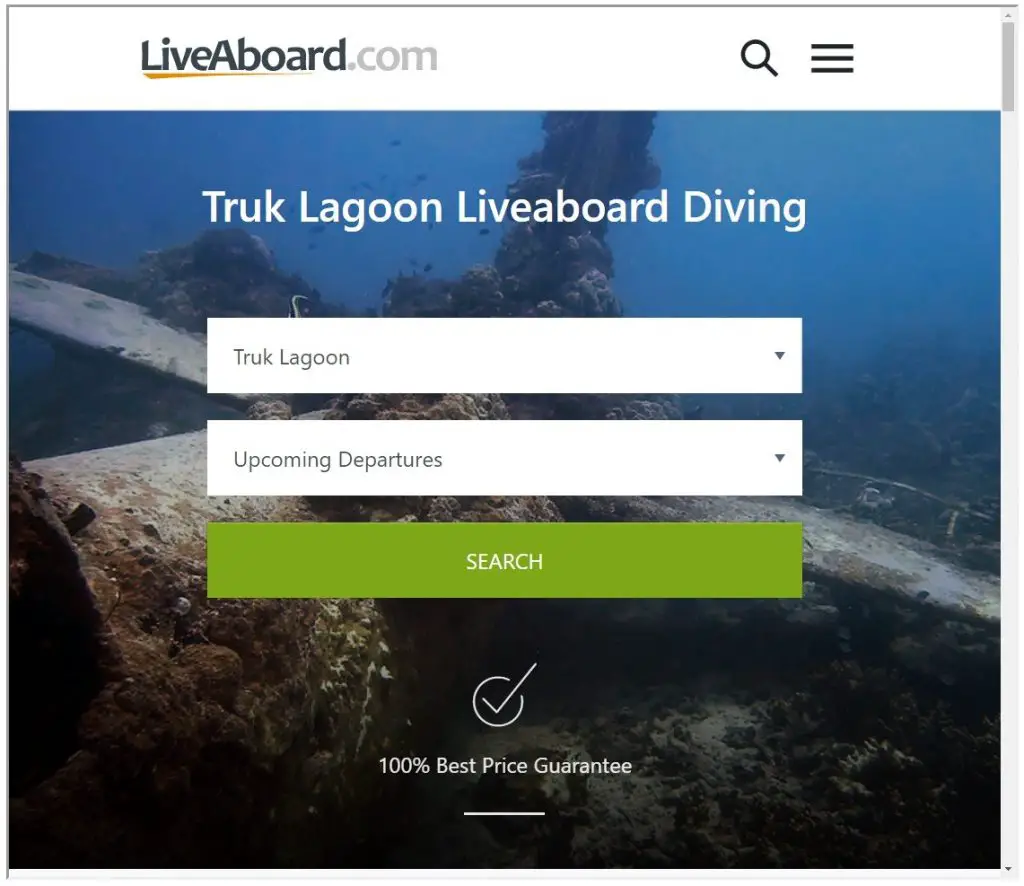
What divers see on the San Francisco Maru wreck:
- A bow gun.
- Trucks.
- Tanks.
- Mines.
- Shells and bombs.
- Aircraft engines.
- Ammunition.
- China.
- Depth charges on the stern.
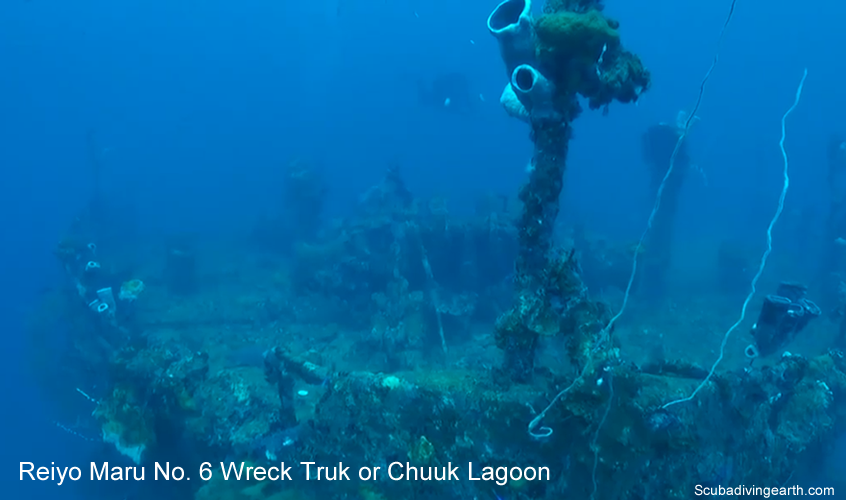
The deepest Chuuk Lagoon wreck – Reiyo Maru No. 6
Reiyo Maru is the deepest of all Chuuk Lagoon wrecks you can scuba dive.
- The Reiyo Maru No. 6 is 67 metres (220 feet) deep.
- The shallowest part of the dive on Reiyo Maru No. 6 is at a depth of 53 metres (175 feet).
- Reiyo Maru wreck is off-limits for most scuba divers, as the limit for recreational divers set at 40 metres.
- The Reiyo Maru wreck was a passenger cargo ship built in 1920.
- She was 121 metres (400 feet) long and weighed 5,446 tons.
- Reiyo Maru was sunk by US aircraft on the first day of Operation Hailstone.
- She was sunk by American dive bombers which came from the USS Essex.
- These bombers scored two direct hits with 1,000 lb. bombs.
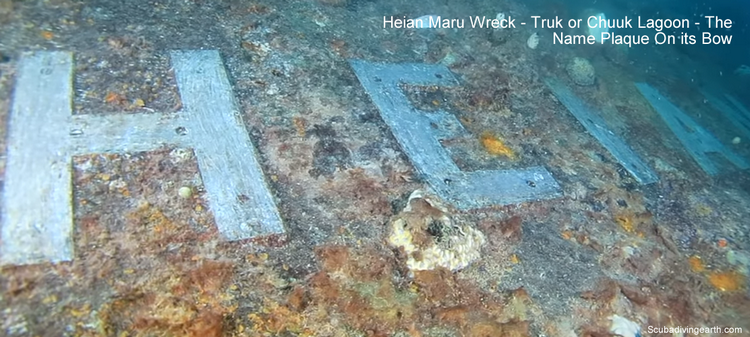
Which is the biggest Truk Lagoon wreck?
The Heian Maru wreck is the biggest Truk Lagoon wreck by weight.
- Heian Maru is the largest of all wrecks in Chuuk Lagoon to dive.
- Heian Maru is a converted submarine tender and weighed 11,614 tons.
- This ghost fleet ship was sunk by American Forces during Operation Hailstone in 1944.
- She was 155 metres (510 feet) in length.
- Heian Maru is at a depth of 11 to 33 metres (35 to 110 feet).
- She is lying on her port side.
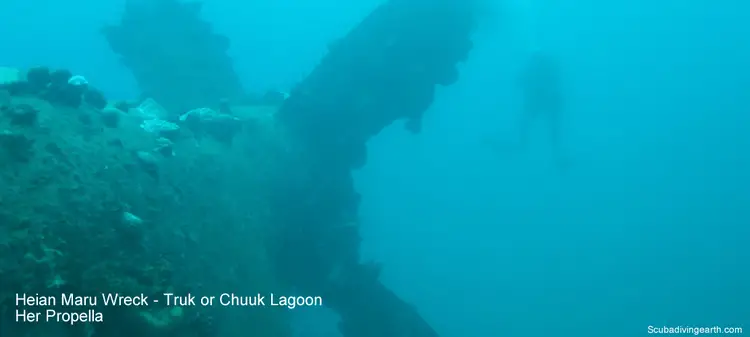
Diving inside the superstructure of the Heian Maru wreck you’ll see:
- Shells (bombs).
- Torpedoes.
- Submarine periscopes.
- China plates.
- Sake bottles.
- Medical kits.
- A bath tub.
- A radio room.
- Plus many other artefacts.
Her name can be clearly seen on the side of her hull, as show in the above picture of her. You can also see her huge propellers too.
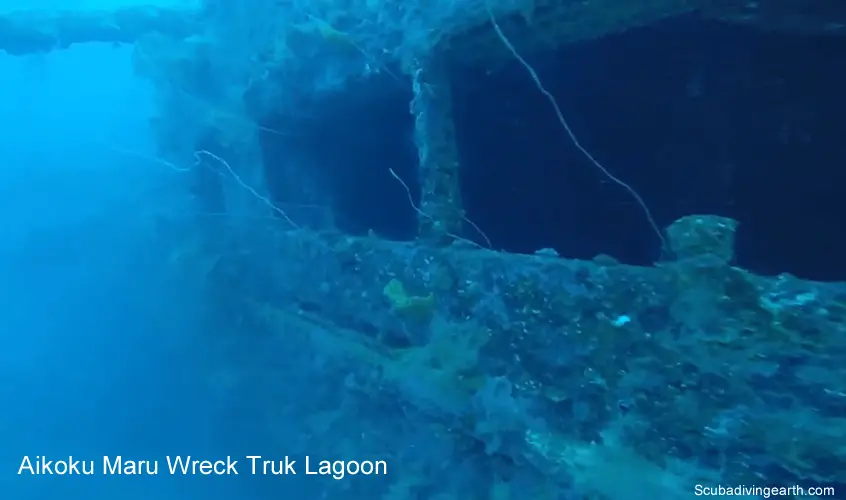
The longest Truk Lagoon wreck
The next measure to judge the biggest wreck in Chuuk Lagoon is using length as a measure. The longest ship of this sunken ghost fleet is the Aikoku Maru wreck.
- The Aikoku Maru, which is a converted passenger freighter.
- She is sitting upright with her fore ship destroyed.
- It has AA guns and a huge stern gun and personal artefacts.
- This wreck is at a depth of 24-64 metres (8-210 feet).
- The Aikoku Maru has a length of 155 metres (527 feet) and weighed in a 10,437 tons.
The shallowest wreck of Chuuk Lagoon
Hino Maru No. 2 is in the shallowest of waters in Chuuk Lagoon.
- The shallowest depth dive on the Hino Maru No. 2 is at just 2 metres (6 feet).
- The deepest part of Hino Maru No. 2 dive is at 18 metres (60 feet).
- This makes her one of 19 wrecks that can be dived by recreational divers limited to 40 metres.
- The Hino Maru No. 2 is known as the ‘Gun High’ wreck.
- Although the bow is only 6 feet from the surface, the deck gun is just 3 feet below the surface.
There are plenty of photographic opportunities on this shallow wreck of Chuuk Lagoon, which is also good for snorkeling too.
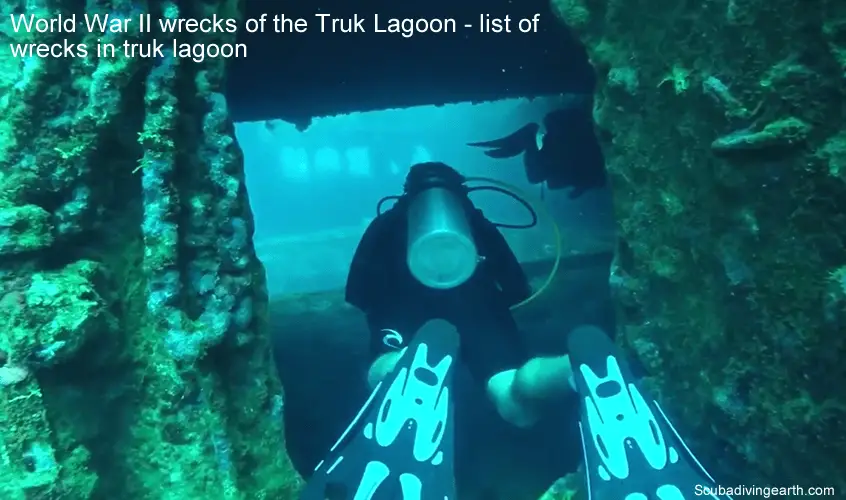
How deep are the wrecks in Truk Lagoon?
As already noted above the Truk Lagoon diving depths range from 15 metres (50 feet) through to 67 metres (220 feet) deep.
Whilst on the one hand the shallower dive can be dived by any certified scuba diver, on the other hand the deepest dive on the Reiyo Maru can only be dived by certified technical divers.
You’ll be able to see the various depths of the wrecks in Truk Lagoon from the above table. But I thought it would be useful to grade the wrecks in terms of depth ranges.
I’ve used the deepest part of the wreck for this purpose, as you don’t tend to dive a wreck for its shallowest part. Which means the following categories of Truk Lagoon wrecks are using the max depths for each of the wrecks.
However, you’ll see that some of the wrecks are only just over the category limit and could easily be dived using a shallower dive profile. This is so long as you limit your depth to your planned depth instead of diving to the deepest part of the wreck you dive.
Always remember: Plan your dive and dive the plan!
This article has a very handy table of how deep the dives are in Truk Lagoon. This table will definitely give you a better idea of which wrecks you might be able to dive on each dive depth profile.
Truk Lagoon wreck diving depths – under 20 metres (66 feet) deep
There are just two wrecks that fall into this category. This is excluding the World War II plane wrecks in Truk Lagoon.
The Truk Lagoon wrecks at under 20 metres (66 feet) are:
- Susuki Patrol Boat No. 34 is 15 metres (50 feet) deep.
- Hino Maru No. 2 is 18 metres (60 feet) deep.
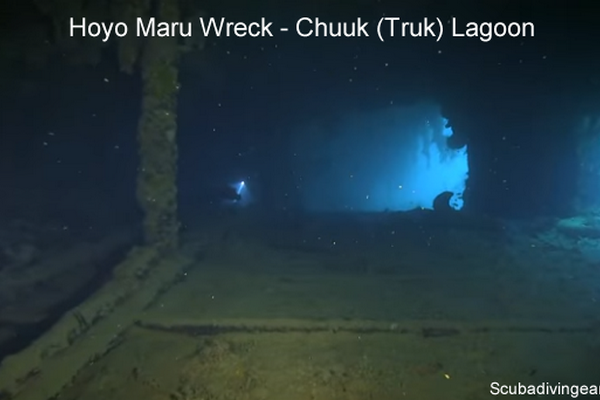
Truk Lagoon wreck diving depths – under 30 metres (100 feet) deep
There are a total of five wrecks under 30 metres (98 feet) deep in Truk Lagoon.
The Truk Lagoon wrecks under 30 metres (98 feet) include:
- Hoyo Maru is 3-30 metres (9-100 feet) deep.
- Futagami Tugboat is 15-28 metres (50-92 feet) deep.
- Sankisan Maru is 15- to 30 metres (49 to 100 feet) deep.
The wreck featured in the above underwater photo is the Hoyo Maru wreck.
- The Hoyo Maru wreck was a tanker.
- At the time she was sunk she was undergoing repairs due to being torpedoed in November 1943.
- She finally came to rest on the seabed on 17 February 1944.
- The Hoyo Maru wreck is 145 metres (475 feet) in length and weighed 8,691 tons.
- As she sank she capsized and now she lies upside down with a broken back.
- The engine room is damaged, but still accessible by scuba divers and the main hull is covered in hard corals.
- She was built in 1936 originally as a commercial oiler, but was requisitioned by the Japanese Navy in 1941.
Futagami Tugboat is small 12 metre (40 feet) boat weighing 625 tons. In the bridge on the Futagami Tugboat wreck there are twin telegraphs and wheel housing. Visibility not so good on this wreck.
The Sankisan Maru has several trucks lashed to the deck. There are many artefacts around her and most of her forward deck is covered in coral. Additionally, there’s an abundance of sea life and there’s excellent visibility on this wreck dive. She was a 4,752 ton cargo transport ship and 116 metres (380 feet) long.
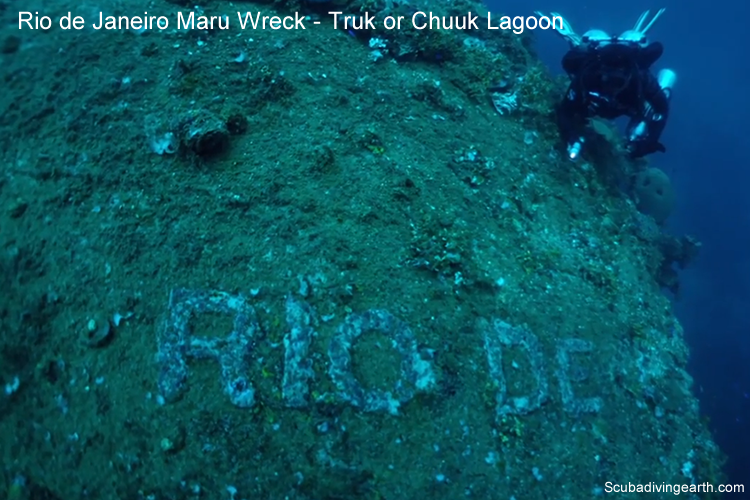
Truk Lagoon wreck diving depths – under 40 metres (131 feet) deep
There are a total of 19 wrecks (which includes the above two wrecks under 20 metres and three wrecks under 30 metres) at a depth of 40 metres or less in Chuuk Lagoon.
That’s a lot of wrecks to dive on a scuba diving holiday. This means you can dive 19 Truk Lagoon wrecks as a recreational diver. Meaning you don’t have to go tech diver deep to enjoy the Chuuk Lagoon wrecks.
A few of the Truk Lagoon wrecks in addition to the wrecks already listed in the 20 and 30 metre depth ranges above include:
- Yamagiri Maru is 15-34 metres (50-110 feet) deep.
- Rio De Janeiro is 10-33 metres (35-110 feet) deep.
- Heian Maru is 15-34 metres (50-110 feet) deep.
- Amigisan Maru is 34 metres (110 feet) deep.
- Yubai Maru is 15-36 metres (50-118 feet) deep.
- Gosei Maru is 3-37 metres (10-120 feet) deep.
- Kiyozumi Maru is 12-37 metres (40-120 feet) deep.
The wreck Rio de Janeiro Maru, as featured in the above image.
- She was a 140 metre (461 feet) long passenger liner and was sunk on 17 February 1944 by US aircraft during Operation Hailstone.
- She is lying on her starboard side in 15-33 metres (50-110 feet) of water.
- There’s abundant see life and great visibility on this great diving wreck.
- Points of interest for scuba divers include a huge stern gun, several large gun turrets and gun barrels in the holds.
- There are also many beer bottles and there’s good access to the wreck with an interesting engine room.

Truk lagoon wreck diving depths – over 40 metres deep
The rest of the Truk Lagoon wrecks lie in waters in excess of 40 metres (131 feet) deep.
These begin with the I-169, as shown in the above image.
The I-169 Submarine, along with the Momokawa Maru, are only just over the recreational diver depth of 40 metres. Both are at a maximum depth of 43 metres (140 feet) of water.
So in theory if you’re a recreational diver and would like to dive another two wrecks of Truk Lagoon, you probably can. So long as you stay off the bottom by the additional three metres (9 feet), you’ll be fine.
One other wreck you could include in your Truk Lagoon dive plan or itinerary, is the Taiho Maru which is at a depth of 44 metres (145 feet) of water.
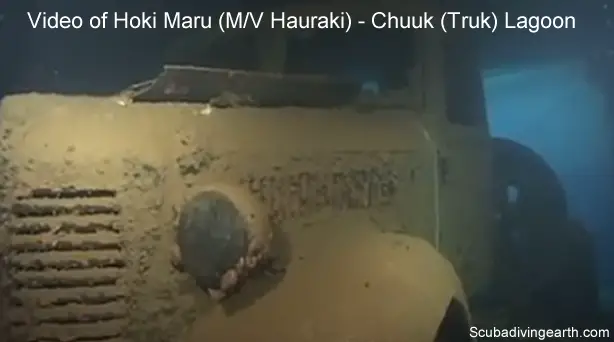
Truk Lagoon wreck diving depths – under 50 metres (164 feet) deep
If you are a dive leader with BSAC you will be certified to dive up to 50 metres (164 feet) deep.
This means you are able to dive on a further eight wrecks in addition to the wrecks at a depth of 40 metres of water. These include the ones discussed above at depths of 43 to 44 metres (140 to 145 feet).
The additional five wrecks include:
- Matsutani Maru.
- Shotan Maru.
- Nippo Maru.
- Seiko Maru.
- Ojima.
- Hoki Maru.

Truk Lagoon wreck diving depths – over 60 metres (197 feet) deep
The rest of the wrecks in Chuuk Lagoon are in excess of 60 metres (197 feet) deep. These require advanced and very deep diver experience and training to dive them.
For these depths of dive you will need to be experienced and certified for mixed gas type diving. You may be better diving with a rebreather. Although having said that, many technical divers still dive to these extreme depths using compress air tanks.
If you are a keen wreck diver and love to go deep, and you have the relevant certifications and experience, then you will probably want to dive on the San Francisco Maru. The San Francisco Maru is considered to be one of the most exciting wrecks of Chuuk Lagoon.
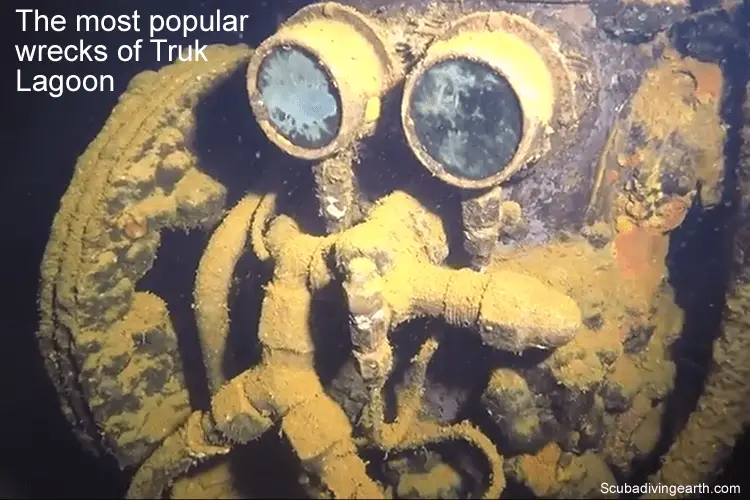
The most popular wrecks of Truk Lagoon
The most popular wreck of Truk Lagoon would include:
- Fujikawa Maru wreck.
- Rio de Janeiro Maru.
- Heian Maru Wreck.
- Aikoku Maru Wreck (see above).
- Nippo Maru Wreck.
- San Francisco Maru Wreck (see above).
- Shinkoku Maru Wreck.
Why the Fujikawa Maru is one of the most popular Truk Lagoon wrecks
Fujikawa Maru wreck is popular because of the iconic workshop compressor which looks like R2D2, as per the image above image.
The Rio de Janeiro Maru wreck is popular because of its huge stern gun. It also has several large gun turrets and gun barrels in the holds. The Rio de Janeiro Maru wreck also has many beer bottles and there’s good access to the wreck with an interesting engine room.

The Heian Maru Wreck is made popular by divers because there are many relics and artefacts. The interior of the Heian Maru is easy to penetrate for divers.
Inside the superstructure of the Heian Maru wreck you’ll see:
- Shells (bombs).
- Torpedoes.
- Submarine periscopes.
- China plates.
- Sake bottles.
- Medical kits.
- A bath tub.
- A radio room.
- Plus many other artefacts.
- Also her huge propeller is still intact, as in the image above.
More Reading: Recovery of the Junkers Jumo 211 (recovery of underwater artifacts)
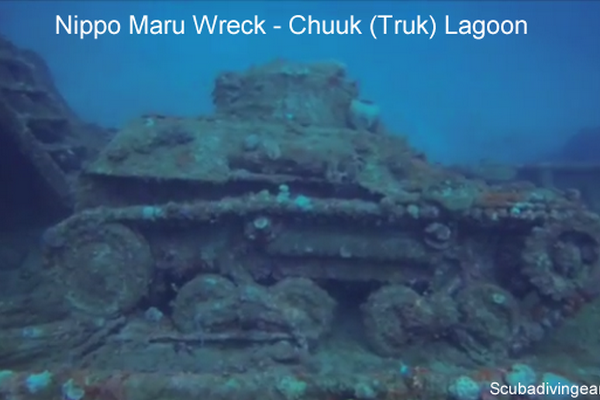
Why the Nippo Maru is one of the most popular wrecks
On-board the Nippo Maru wreck she has:
- Coastal defence guns.
- Field artillery.
- Trucks.
- A battle tank (see above image).
- Machine guns.
- Shells.
- Mines.
- Nippo Maru also has a particularly photogenic bridge.
These are what makes her one of the most popular Truk Lagoon wrecks to scuba dive.
To see the location of the Truk Lagoon wrecks on a map, please follow this link to: Truk Lagoon wreck map.
I hope you enjoyed this article about Truk Lagoon wrecks
I’d love to hear from you. Tell us about your adventures of diving and snorkeling, in the comments below. Please also share your photos. Either from your underwater cameras or videos from your waterproof Gopro’s!
If this article hasn’t answered all of your questions. If you have more questions either about snorkeling or scuba diving (or specifically about Truk Lagoon wrecks), please comment below with your questions.
There will also be many more articles about scuba diving (and snorkeling) for you to read and learn about these fabulous sports.
Have fun and be safe!

